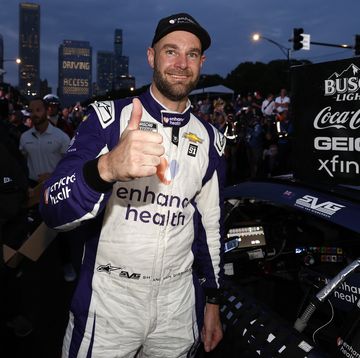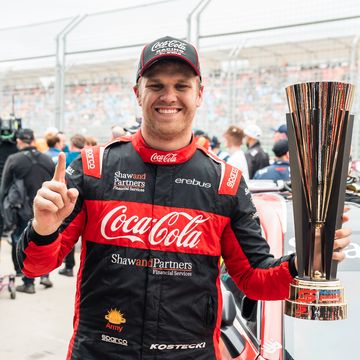At the end of a calamitous and crazy Sunday in Chicago, Shane van Gisbergen, a stranger in these parts, emerged from the wet and near-darkness to win the first major NASCAR race on a big-city street course.
With flashflood warnings posted and the 2.2-mile street course showing puddles in critical spots from inches of rain, NASCAR outran the weather and reached a checkered flag despite the persistence of the elements. Because of impending darkness, the scheduled 100-lap race was trimmed to 75, changing strategies over the closing miles.
Little could impact the talent and experience of the 34-year-old van Gisbergen, however, who used his background in Australian Supercars, full-bodied cars similar to Cup racers, to slide through a damp track and win in overtime.
The native of New Zealand became one of only a handful of drivers—and the first since Johnny Rutherford in 1963—to win in their first Cup Series race.
Van Gisbergen drove for Trackhouse Racing and its Project 91 program, which is designed to give championship drivers from other disciplines a shot in Cup. Van Gisbergen, a three-time Supercars champion, cashed his chance in the most impressive of ways.
“This is what you dream of,” van Gisbergen said. “Hopefully, I can come and do more.”
Following in the top five were Justin Haley, who lost the lead to van Gisbergen late in the race, Chase Elliott, Kyle Larson and Kyle Busch.
Drivers started the race on treaded, wet-weather tires, but all teams switched to standard Goodyear slicks before the halfway point as most of the track dried. There were numerous slides into the wall and tire barriers, however, as drivers tried to gauge how the surface was changing.
Rain, Rain Went Away
Rain. More rain. Biblical rain. Standing water on the race course. Pit road flooding. Umbrellas aplenty, and streams running along Michigan Avenue. A flashflood warning in the city.
Weather did what skepticism could not—put a damper on what looked to be a spectacular debut weekend for NASCAR’s Chicago Street Race.
Among the results: A rare NASCAR ruling that resulted in a race—the Loop 121 Xfinity Series event that opened the weekend schedule Saturday—being called official before it reached the halfway point.
Twenty-five of the scheduled 55 laps in the Xfinity event were completed Saturday before weather—in particular, lightning warnings—forced officials to postpone the race. It was scheduled to be completed Sunday morning before the afternoon Cup race, but heavy rains made the track much more suitable for boat racing.
NASCAR decided to make the race official two laps short of halfway, declaring race leader Cole Custer the winner.
“With standing water and flooding a significant issue at the racetrack and throughout the city, there was no option to return to racing prior to shifting to NASCAR Cup Series race operations,” NASCAR said in a statement. “Throughout the entire planning process for the Chicago Street Race, our relationship with the City of Chicago has been strong and among the most valuable assets in reaching this historic weekend.
'In the spirit of that partnership, returning on Monday for the completion of a NASCAR Xfinity Series event two laps short of halfway was an option we chose not to employ. Based on several unprecedented circumstances, NASCAR has made the decision to declare Cole Custer the winner of the race.”
John Hunter Nemechek, Justin Allgaier, Brent Moffitt and Austin Hill followed in the top five.
Why Hamlin Won't Forget Windy City
Denny Hamlin is not prone to exaggeration. So his comment after winning the Chicago Cup pole Saturday drew a bit more than the normal amount of attention.
Hamlin described Saturday as “probably my single best day at the racetrack in all of my career, for sure.”
Hamlin is 42 and had won 38 pole positions entering Chicago, so adding another first starting spot wasn’t the thing that defined his day. He was among the drivers who had poured praise on the race organizers and the massive amount of work that had gone into the unique race weekend.
Hamlin ran 89.557 miles per hour. Tyler Reddick was second. A surprising third was Shane van Gisbergen, a pure rookie who would light up the course Sunday on the way to a stunning victory.
NASCAR Blows Away the Fan on the Street
Despite the miserable weather, NASCAR activities brought a new vibe to downtown Chicago.
During Sunday’s abbreviated Cup race, people who apparently did not have race tickets crowded outside the turn areas of the track hoping for a look at the action. Many held their cell phones over the track fencing to record cars moving through the street corners.
Nancy Salters, a visitor from Detroit, was in town with friends to visit Chicago museums and wasn’t aware a race was scheduled on streets she said she had driven often. The roar of engines drew her to the outside of the course.
“The noise is incredible,” she said, showing cell-phone clips of cars racing by. “I would never have imagined something like this happening here. How they made it work I don’t know. But definitely something new for me.”
NASCAR Makes History; Now What?
Despite the challenges of the weekend weather and racing on a track that was not in shape for ideal competition, NASCAR’s bold experiment was mostly a success. The weekend proved that racing could be sold in a city typically enveloped in the ups and downs of its beloved sports teams. Officials—most notably event president Julie Giese, one of NASCAR’s most respected executives—seemed to have virtually every part of a complex operation under control.
On Friday, she had commented about weather being the one thing she couldn’t control, and it indeed poured cold water—literally—on the parade.
NASCAR is scheduled to run on Chicago streets for the next two years and is exploring opportunities in other big cities. It seems likely that the “downtown” element will be a part of Cup schedules for the foreseeable future.
















